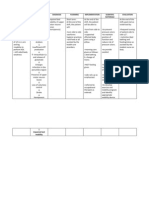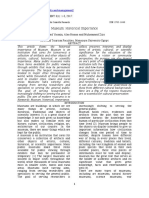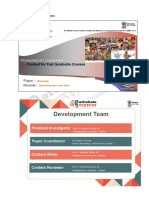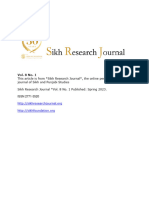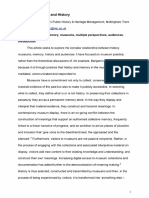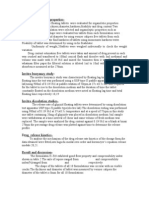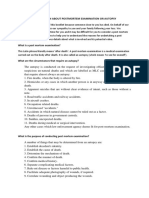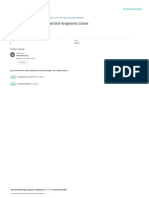Museum Perspective
Museum Perspective
Uploaded by
Swati NupurCopyright:
Available Formats
Museum Perspective
Museum Perspective
Uploaded by
Swati NupurOriginal Description:
Original Title
Copyright
Available Formats
Share this document
Did you find this document useful?
Is this content inappropriate?
Copyright:
Available Formats
Museum Perspective
Museum Perspective
Uploaded by
Swati NupurCopyright:
Available Formats
The Museum is National Author(s): Kavita Singh Source: India International Centre Quarterly, Vol. 29, No.
3/4, India: A National Culture? (WINTER 2002-SPRING 2003), pp. 176-196 Published by: India International Centre Stable URL: http://www.jstor.org/stable/23005825 . Accessed: 10/01/2014 03:16
Your use of the JSTOR archive indicates your acceptance of the Terms & Conditions of Use, available at . http://www.jstor.org/page/info/about/policies/terms.jsp
.
JSTOR is a not-for-profit service that helps scholars, researchers, and students discover, use, and build upon a wide range of content in a trusted digital archive. We use information technology and tools to increase productivity and facilitate new forms of scholarship. For more information about JSTOR, please contact support@jstor.org.
India International Centre is collaborating with JSTOR to digitize, preserve and extend access to India International Centre Quarterly.
http://www.jstor.org
This content downloaded from 202.41.10.7 on Fri, 10 Jan 2014 03:16:36 AM All use subject to JSTOR Terms and Conditions
Kavita Singh
The Museum
is National
The Idea of a National
Museum
with the national anthem, the national emblem, the
national festival, archive, a nation and needs its national museum. Poor
Along
national
its national
library, indeed
its is
lay claim to enough history to fill an archive, fill a library, and enough to artefacts to fill a enough scholarship museum! the project of a National Thus, shortly after Independence, in an imposing Museum for India was begun. Housed building at the the country that cannot ceremonial treasures the ancient Like nationhood Asian, national new museum heart of New Delhi, this Museum was filled times. was with art that traced culture all new and the nation's history the National from earliest Museum As the
of a new nation,
to celebrate of its
of the young state. nations, India modelled of the colonial American master nations, Latin became
the accoutrements states. Here, the erection
on those museum
as in most
African
independence.1 The new nation
It was would
seen
an act of great symbolic as a means of retrieving one's own past. collect, protect and assign value to its own of its erstwhile its citizens
of a grand after importance
heritageindependent masters. And it would symbolic affirmation
of the scrutiny and judgements with share its masterpieces
in a
urgent to overcome difficult early years. was to establish equivalence national museums
of their rights. These gestures were sufficiently the conditions of financial of the stringency to make a museum of one's own For national
with Spain, France or Britain whose grand had held and shared of Madrid, Paris and London
This content downloaded from 202.41.10.7 on Fri, 10 Jan 2014 03:16:36 AM All use subject to JSTOR Terms and Conditions
Kavita
Singh
/ 177
the nation's years.
patrimony
with its citizens to have in the needed
for one, two, or three hundred museum was inspired by what the
But while examples museums related
the desire states
a national European to do was tale
of museums of new
metropolises,
what had been done
in Europe. a supraor trans-national civilisation. as their own Claiming progressing Renaissance to ancient Greece
different from markedly The old European 'national' museums of the history of Western heritage the art of ancient Egypt, and Rome, and then
to directly the museums a Europe, great European developed all that it admired 'universal survey'2 of the history of art, incorporating into its own past.3 (Adjunct galleries might house artefacts from other world cultures which they served to expand had no place in this evolutionary the territory of connaissance.) sequence, but
Transcending nationality, the narrative retold by the museums in Europe was one of world dominance. Among the new nations, the was different: national museums were required as shrines to purpose the national culture, confining their scope to artefacts produced through the ages but within the boundaries of the modern state. This was the project desired and assiduously and non-western nations. developed by the newly decolonised
The Garden of Sculpture its formulation National In eternal, Museum and it had and had celebration two tasks: of Indian it had was national culture, the was
to show
that India
to show
Primordialism demonstrates sense.
is useful
that the nation
great. in the self-fashioning it of nations; has always existed, at least in a spiritual
that India
The periods when the land was not a nation, was divided, or in can then be as the nation's natural subjected, presented interruptions destiny That the nation its possession high national chosen is and always was great is demonstrated through of a high culture over a long period. In formulating a strands are culture, one strand or a few interrelated or mainstream culture from representative of local cultures. Typical candidates for the associated that is group the present), (thus the past legitimates with an ethnic
as the dominant,
among the proliferation culture are 'mainstream' dominant in the present
period
This content downloaded from 202.41.10.7 on Fri, 10 Jan 2014 03:16:36 AM All use subject to JSTOR Terms and Conditions
178 / The Museum is National is possessed of a textual tradition (which provides historical evidence as well as an expression of intentionality), is relatively widely diffused that it can claim to be and offers in its history at (so proto-national), least a few figures ( patrons, artists) who can function as national heroes. If the National Museum was to demonstrate that India had been great, it was inevitable that the been, and had always always main burden of the narrative would fall upon one category of objects: stone sculpture. the They alone had survived plentifully through centuries, evidence. to trace a deep history through their However of stone sculpture lay not just in their but also in their resemblanceat least superficiallyto the possible the value of Greek of India, and it was
antiquity stone sculpture stone
and Roman antiquity. By foregrounding the Indian art the enthusiasts of could sculpture testify to and a civilisation that in some respects rivalled European civilisation which might also be considered What had to be depressed Indian and had its equivalent.4 were the actual points of contact traditions. Early Western school AD, in in a
between scholars whose
sculptural European at the of Indian art the Gandhara placed apogee 'Greco-Buddhist' from the 1st- 2nd centuries sculptures, of the subcontinent Buddhist
depicted writers spurned Gandhara art. They style. Nationalist to the shifted Indian sculpture's Gupta period (5th- 6th highest point and of form was achieved, century) when a certain sophistication brahmanical forms proliferated with Buddhist ones. along Naturally, Hellenistic it was the nationalist of the National history that is materialised Museum. for us in the galleries
the northwest
themes
Museum is Today, as much as at inception, a visit to the National which almost dominated its of by sequence sculpture galleries5 occupy the entire ground floor. As we shall see, this is the only set of galleries that is linked sequence. chronological The first gallery on the ground floor is devoted to the Harappan civilisation. Just as historical research has not been able to establish firm connections the Museum which this enigmatic civilisation and future history, this gallery and the next too offers no bridge between between 1500 years to pick up a narrative that will to form a coherent,
leaps across some henceforth be continuous. The
of the Museum sequence proper evolutionary with a gallery of Maurya and Sunga art, with sculptures to 2nd centuries BC. The sculptures are all from Buddhist
commences from the 3rd monuments,
This content downloaded from 202.41.10.7 on Fri, 10 Jan 2014 03:16:36 AM All use subject to JSTOR Terms and Conditions
Kavita
Singh
/179
and are mostly railing pillars which depict Jataka stories, donors, tree At the threshold between this and the next room spirits and guardians. stands a Bodhisattva from Mathura. the debate scholars on the evolution had This figure inaugurates, as it were, of the Buddha image, a hotly contested of the 20th century. European due to developed image
issue in Indian
art history in early decades asserted that the Buddha
artists to the Gandharan school. impulses brought by Greek maintained that it developed from popular Nationalists indigenously cults that icons of local commissioned spirits that yaksha guardian this Bodhisattva. The presence of this Bodhisattva, closely resembled located aligns their first Gandhara just before visitors encountered the museum's narrative firmly with the nationalists. Buddha,
The next room presents three schools of sculpture that flourished in three different parts of the subcontinent, from the simultaneously 2nd century BC2nd century AD. These schools are represented through three rows long wall. of sculptures: one down the centre and one along each On the left we see sculptures from the Gandhara school, in the Indo-Greek under Hellenistic influences kingdoms;
developed in along the centre are the early images from the sculpture workshops and the right wall are relief from Mathura; along panels to the beautiful Roman-influenced school Nagarjunikonda, belonging the masterpieces of Amaravati. the museum Although a few from Mathura that are possesses just sculptures arranged along central the spine of this room, there is no doubt that what is physically tradition. For it is the art of here is also posited as the 'mainstream' Mathura that develops into the calm and poised period of the which was hailed by nationalist art sculpture Gupta period, historians as the 'classical' period of Indian art. Here, they said, Indian art arrived at a magical moment when balance, and finesse, elegance restraint all metbefore of medieval skill turned schools. And florid excess to virtuosity, engendering the we come upon the sculptures Kushana that produced
of the Gupta period next, in a special gallery that houses a series of fine images of the Bodhisattva, Vishnu and Shiva from the Buddha, most Sarnath and Gwalior. This important Gupta sites at Mathura, shrinelike room is the only gallery exclusively dedicated to one period and school. Its special quality is all the more pronounced as, after the narrative breaks down and later Gupta gallery, the chronological medieval is shown in a vast of and sculpture jumble places, periods styles.
This content downloaded from 202.41.10.7 on Fri, 10 Jan 2014 03:16:36 AM All use subject to JSTOR Terms and Conditions
Buddha Coll National 2nd century AD Gandhara Museum ACC. No. 87.1153
This content downloaded from 202.41.10.7 on Fri, 10 Jan 2014 03:16:36 AM All use subject to JSTOR Terms and Conditions
Coll
National
Bodhisatlva Maitreya Kushana, 2nd century AD Museum ACC. No. 59.530/1
This content downloaded from 202.41.10.7 on Fri, 10 Jan 2014 03:16:36 AM All use subject to JSTOR Terms and Conditions
Bodhisatlva Gupta, 5th century AD, Sarnath Coll National Museum ACC. No. 49.113
This content downloaded from 202.41.10.7 on Fri, 10 Jan 2014 03:16:36 AM All use subject to JSTOR Terms and Conditions
Vishnu Gupta, 5m century AD, Mathura Coll National Museum ACC. No. E.6
This content downloaded from 202.41.10.7 on Fri, 10 Jan 2014 03:16:36 AM All use subject to JSTOR Terms and Conditions
184 / The Museum is National as told by the Museum, is a sculpture, in which naive and eclectic styles history of progressive development a towards but From the struggle sophisticated 'pure' expression. off), 'foreign' influence in the Mauryan period (which was shrugged history to the naive and charming folkish art of the early Buddhist stupas, to the Indo-Greek and finally byways and the earthy Kushana-Mathura to the 'classic' phase of the Gupta periodit seemed as though Indian that finally was achieved in the striving for something became also the period. Gupta By this turn, Buddhist sculpture of the Indian tradition of Hindu which came authentic, art, prehistory sculpture robustly into its own at this point. If Indian sculpture had the unitary aim of evolving into Gupta then Gupta sculpture had the unitary aim of perfecting a sculpture, theme: of the human and the male single particularly body. in Indian sculpture Everywhere the full-bodied female form. achievements seen Vishnu, inward spiritual But there is the inescapable of presence in the National Museum the was The of Indian
again Rama
of the Gupta period are predicated upon the male body, and again in the figure of the Buddha, the Bodhisattva, or Shiva.
ascetic's
the Subtly rising and falling flesh beneath robes, the in-held breath of the yogic body, the eyes turned themselvesthese became the corporeal upon signs of attainment. Not only does the yogic male body allow an
from the embarrassing of the female form all too escape presence common in Indian sculpture, the single theme of the iconic male shifts attention away from the cultic differences between Brahmanical and and Saiva imagesfurther of unifying the purpose With the of the divine male as the Gupta sculpture. body presented real theme of Gupta the period became an icon of sculpture, Hindu, Vaisnava, nationalism, integrating diverse people towards a common and spiritual goal. After the Gupta narrative of the gallery, the chronological National Museum breaks down. The two 'medieval' rooms are jumbled, by side. from different regions and periods side placing sculptures The confusion of these rooms might be a reflection on the
state of the field; for early studies of Indian sculpture had concentrated monuments were not upon the ancient period, and later medieval fully interiorised the phase most has been into the art historical prolific little attention. in the creation narrative. But this means that of Brahmanical monuments
in the colonial period Understandable given or even at the time of Independence, this medieval medley which now
This content downloaded from 202.41.10.7 on Fri, 10 Jan 2014 03:16:36 AM All use subject to JSTOR Terms and Conditions
Kavita
Singh/
185
persists
within
the National
Museum
these medieval decades, intervening to intensive subject study. Whatever may be the reason that the medieval have remained undifferentiated, it has in Indian stone sculpture developments and central India and could be placed within process of development. times of tremendous distinctive The medieval
is inexplicable, sites and schools
for in the have been
sculpture galleries an interesting effect. Early are traced mostly in north and unified were phases
a single and later medieval
regional projects, cults and iconographic innovations. But styles, localised with the of east and west north, south, dealing particular qualities divides the river of Indian history into many distinct streams; regional identities become stressed over the national, and the strong centre is subjected to the forces of the centrifuge.
achievementsenormous
And the Weeds in the Path nee the ancient sculpture narrative terminates is dealt with the Musem's is
historical Central
and the rest of the museum
of specialised composed galleries for Manuscripts, Asia, Textiles, Carved Wood, Arms and Armour,
Painting, Coins and
If downstairs the and Ethnography. Jewellery, and Anthropology museum is arranged with the intention of roughly chronologically the river of the museum turned into a series following history, upstairs of still pools in which we might reflect upon the technical finesse different kinds of artists and artisans as they work on metal, wood cloth. One of or
from of the shift in this mode of display consequence it was intended or notis that to 'material'whether 'chronology' artefacts temples produced are placed outside outside shrines and Hindu of the early Buddhist the realm of history. When the Museum
an object produced in an Islamic context, it is absorbed into displays or historical a display not of a particular cultural period, but of a Thus the sword of a material: textiles say, or metalwork. particular a sash worn by an example of damascening; Mughal prince becomes an illustration Even becomes of a block-printing technique. in the Painting have a there seems to been Gallery pronounced the or Mughal for traditions over Deccani preference 'indigenous' the ones.7 The result was and is that one can walk right through a nawab
This content downloaded from 202.41.10.7 on Fri, 10 Jan 2014 03:16:36 AM All use subject to JSTOR Terms and Conditions
186 / The Museum is National National had been Museum in India. and be only dimly aware of the fact that the Mughals
In the early fervour of Independence, the formulation of a national culture was undoubtedly India's powered by a desire to recover untainted 'external' influences of the traditions, indigenous by or the Islamic world. Engaged in a project of recovery of the European ancient past, scholars in the field may not have spared a thought for the more recent past which, it would have seemed at the time, had not suffered degree of neglect as the 'much maligned monsters' in the further reaches of history. In today's context however, the National Museum's omissions are startling and its narrative, partisan. Let us be aware critiquing should make and the National becomes exclusions, Museum. that we should methods between exercise some caution and here. In we from the same
the Museum's a distinction
the intentions
that probably in the context Museum to take a less
display, the way it appears to us today, it at its formation. If we see guided of its predecessor-museums it view of the inclusions,
of classification
possible
than sinister
and deviations in the tale of the National trajectories Instead of reading a theory of conspiracy in the exclusion of India's late-medieval, and Islamic past from the Museum's historical one see it instead as an unintended victim of the narrative, might Museum's within were to accommodate two colonial attempt epistemologies its walls. But for this one would need to glance backward of museums and in India, the purposes for which upon the kinds of order they imposed at
the early history established, collections
they the
in their charge.
A Concise
Synopsis institution
of India of the museum came to India
The which...
as part of the vast knowledge-creating project of the Raj. The intention of early British museums that took India as their subject was to "present
to the eye a typical collection of facts, illustrations and examples will give a concise synopsis of Indiaof the country and its material the people and their moral condition."8 The productsof to be a metonym for the land, presenting all the pertinent information about India through an inventory of her and human resources. materials, Moreover, products, objects in the museum collections were
This content downloaded from 202.41.10.7 on Fri, 10 Jan 2014 03:16:36 AM All use subject to JSTOR Terms and Conditions
Kavita
Singh
/187
museum or fallen race.
would
to the degree to which India had achieved short of civilisation, fixing the 'moral status' of the subject
bear witness
the first museums that took India as their subject Accordingly, in India or in were in scope. Gathering9 (whether Britain) encyclopaedic science and art under one roof, these museums included scientific, economic10, museum Geology, microcosm complete correctly represent The Museum Museum and archaeological12 collections. A satisfactory needed to possess sections for Natural History, Ethnology, and the Industrial Arts. The museum-as Archaeology, part of the imperial fantasy of being able to create in which archive of the empire, comprehensive classified and labelled could adequately array of samples the imperial domain.13 and two earliest museums and was dedicated Museum to India in 1801 were the India The East India India in London, in London the Indian established in Calcutta. by the was a a industrial"
to house the collections being brought to England by officers Company of the Company. No branch of knowledge was outside its purview: its collections included of insects and molluscs, minerals specimens and textiles, as well as jewels and arms clays, and manuscripts taken from the treasuries of defeated Indian princes. This museum had a chequered history, reflecting the rises and falls of 'India' within the British With the demise of the Company in public imagination. were transferred to the Crown, which dispersed 1858, the collections the collections institutions.14 among various London While waned the fortunes of 'Indian' museums in Britain waxed and movement within India through the 19th century, the museum the territory and gathered gathered strength as scholars explored in their researches. The Indian in the course of Museum samples museum of India, that housed began its collections and
that other great encyclopaedic life in 1814 as the museum of the Asiatic Calcutta, made
Society As the first museum instituted on Indian by its member-scholars. of London, dedicated to the study soil, it was, like the India Museum of 'art and nature in the East'. and It included and specimens of natural available geology, zoology, or 'industrial arts'. scientific scientists in Calcutta the Indian and was antiquities Both museums collections historians.15 currently saw their mission the staff were
history, craft skills
their taken
and
as primarily dominated by
and natural Museum.16
In 1866, the Asiatic
over by the Government As the prime museum in the capital
Society Museum and transmuted into of British
This content downloaded from 202.41.10.7 on Fri, 10 Jan 2014 03:16:36 AM All use subject to JSTOR Terms and Conditions
188 / The Museum is National India, it was nurtured Imperial hierarchy of pride of place among the evolving and for some time it was the and local museums; as India's central, indeed as India's
museum.
It occupied
central, provincial in this official policy that all truly precious collections be centralised and one museum, in the provinces retain copies while museums duplicates.17 Today, is as much the institutional form of the Indian Museum of Calcutta a curiosity it preserves as any of its exhibits; moment in the early history of museum-making. particular mere twenty further on into the Raj, specialist years had grown knowledge became too unwieldy
for us a Even fields a of
to such a point that the encyclopedia indica for the one museum, one scholar or one
to manage. The days of encyclopaedic government department museums were over, and museums that were set up henceforth limited themselves to a particular discipline or field of knowledge. Thus there were specialist museums for natural history, for medicine, for forestry, or for art. What today constitutes the field of 'art' was itself split into of two monuments, categories, antiquitiesthe sculptures, inscriptions, coins and relics that could yield information about India's historical pastand 'industrial arts': the living craft skills that were so admired opportunities From 1851 onwards, in Europe, and for both India which and were seen to present economic Britain. of India had begun vigorous in which Indian materials,
the Government
in international exhibitions participation and and advertised were to an international crops products displayed market. These exhibitions were highly successful as a marketing device that expanded in many parts of the the demand for Indian products world. As trade in India's (which art-wares museums materials, collected and industrial grew, the economic and about raw information samples
useful to the crops and craft skills) became increasingly Government's Revenue and Agriculture Several Department. Industrial Art museums were established all over the country, in which examples exportable exhibition. museums of native The was skills were that system collection logical gathered as a ready reference or as an could be sent to the next efficiently of arrangement for the 'industrial art' the different showing many processes for say, textiles, or woodworking, or
by 'industry': and skills available within India metalsmithy. Meanwhile governmental
growing numbers care for monuments
of antiquarians were pressing for all over the country. In decaying
This content downloaded from 202.41.10.7 on Fri, 10 Jan 2014 03:16:36 AM All use subject to JSTOR Terms and Conditions
Kavita
Singh
/189
to their pleas, the Archaeological response museums 1861. The task of archaeological and date fragments other remains however, valued
in Survey was established was to collect, decipher and and
collected These museums sculptures antiquities. in various media of monuments, coins, inscriptions from the distant dominated ancient over were The
remained the most
field of early archaeology , past. which attitude, by an antiquarian and the medieval.18 By large, when displayed they were arranged of objects in a from
archaeological
collections
order, keeping together groups broadly chronological the one site or with a shared iconography. In recognition the field of the divergent interests that occupied two of 'art,' in 1882 the Government of India split the field between
and fine arts Henceforth, departments. archaeology government which would arrange for would remain with the Home Department moral duty the excavation, of antiquitiesa survey and protection for the government that offered no financial returns. Practical Arts, of Revenue and museums would exhibitions, go to the Department for the and Agriculture, which would link art schools and museums furtherance labour of industry. The official who oversaw this division of observed
'The main object of the exhibition of Indian products is not the gratification of occidental curiosity, or the satisfaction of aesthetic longings among foreign nations, but the development of a trade in these products, whether raw or manufactured, rough or
artistic.'19
It should
be clear by now that the two typologies of display seen within of the two the National Museum bring together the intentionalities the National kinds of colonial museums. Downstairs, principal is an archaeological museum. museum. These two taxonomic an it becomes Upstairs which were united systems
Museum industrial
of the colonial museums encyclopaedic period, and then split apart in the face of growing were specialist knowledge, once again brought to fill the halls of the new National together Museum. Why? It would seem that in the desire to create an institution vast and grand enough to be the National the Museum, enough the different kinds of museum founders could only think to aggregate that then existed.
in the earliest,
This content downloaded from 202.41.10.7 on Fri, 10 Jan 2014 03:16:36 AM All use subject to JSTOR Terms and Conditions
190
/ The
Museum
is National
There
give shape new meanings for the art within. In the face of a new task in a new era, the creators of the National instead of creating a new Museum,
is surely a failure of imagination here, in the inability to to a new form of a museum, and to make new values and
fell back on one that was more that 150 years old.20 If epistemology, there is any consolation, it lies only in the concession that we may now make, that perhaps later-medieval and Islamic art are excluded from the Museum's application national narrative unthinking of two incompatible in an unintentionally, of systems taxonomy.
Three Quadrants the National museum, If history Museum's colonial exercise centre
Full Museum is stalked because Museum that derives by the ghosts of the colonial it lives in a haunted house. The reveals from that it is not just the of the epistemology
it is perhaps of the National sense of order
and the its very location, period. The idea of this Museum, of research and collecting on which it was founded, all derive of New projects. Even the Museum's presence in the ceremonial Delhi is not so much the assertion of a new national as the completion of an old colonial design. was taken in 1911 to shift the capital of British to Delhi, there were plans for the erection of
from colonial confidence When India
as much
the decision
from Calcutta
structures to house the great archives of colonial imposing The original plan for New Delhi had always knowledge. envisaged the intersection of Kingsway and Queensway (today renamed Rajpath suitably as the nucleus of four important institutions. This Janpath) intersection was at the halfway mark of the grand processional the Viceregal Palace and the Memorial pathway stretching between Arch. Four large lots were blocked out here: on the northwest, for the Records Office and the War Museum; on the northeast for the Medical Museum; broad southeast for the Ethnological and on the Museum; for the Imperial Museum. each other across the Mirroring avenues would be the museums dedicated to the sciences of on the southwest and
war and peace, death and life, as it were; and of the arts of forest and of yesteryears. Around city, the tribal of today and the civilisation this hub would be concentrated the sum of knowledge and understanding and a half. of India that had been gathered in the past century
This content downloaded from 202.41.10.7 on Fri, 10 Jan 2014 03:16:36 AM All use subject to JSTOR Terms and Conditions
Kavita
Singh
/191
The grand set of museums never were erected. This project overtaken presumably by other, larger events. The first world ocurred; conditions investment and when within in such it was India over and most of New were Delhi was
was war
built, the
triumphal taking up the project after the second world war, when the loss of the Indian colony was apparent to all. While Lutyens' some plan for this hub was never completed, structures to occupy three of the four quadrants. The Records Office was built according to plan, and is now the National Archives India. In of the space for the the Imperial Museum, the Archaeological its offices and added a small structure to house Sir Survey gained Aurel Stein's collection of Central Asian artefacts. In the place for the Medical Museum, however, temporary military barracks were built. This plot was given over to the Indira Gandhi National Centre for the Arts in the 1980's. The fourth quadrant, intended for the ethnological Defence Minister museum, remains empty to this day. Our honourable has long wished to see a War Museum built here. If he succeeds, the quadrant will be filled and will very nearly discharge Lutyens' original plans. Of all these plans for the quadrant, the only grand project to be taken up in the early years of Independence was the building of the now recast as the Museum. What National were Museum, Imperial in which the project of an Imperial Museum was after Independence? And in what way was the project the Imperial Museum to turn 'national'? transformed, allowing revived the circumstances did come
unsettled to discourage sufficiently There was even less sense in gestures.
Delhi-London-Delhi trace To India the history of Delhi's centrepiece, now to an event that occurred after India's Remembered art, the show mounted we must turn our A scant
attention in London moment had
in London.
three months and Pakistan.' for Indian
the Royal Academy Independence, an ambitious exhibition titled 'The Arts of in Indian art history as a significant of as a timely gesture of the independence after the fact. That it
has been spoken on the part of the British, a gracious celebration of India and the creation of Pakistan very soon was housed institution,
in the Royal Academy, a conservative and Eurocentric has been construed as an ultimate acknowledgement on
This content downloaded from 202.41.10.7 on Fri, 10 Jan 2014 03:16:36 AM All use subject to JSTOR Terms and Conditions
192 / The Museum is National the part of the imperial masters indeed of the nation-worthiness the first time that the British of the deep level of civilisation, and of the ancient land. In truth this was was treating Indian
art establishment
rather artefacts as fine art, speaking of its carved stone as 'sculpture' that were distinguished their than as 'antiquities' for merely age. It was inevitable that the Royal exhibition would Academy coming, as it did, just three months after piquancy, it happens, As the exhibition's independence. exquisitely of a number of therefore, the inclusion appropriate timingand acquire Indian political in fact an accident. In the late '20's correct gestureswas politically the Academy had launched a series of very successful exhibitions of art from other cultures; art scholars and and a group of Indian collectors The scheduled had advocated a similar show for Indian 'International Exhibition of Greater Indian art as early as 1931. Art' had been
for January 1940, when World War II intervened, scotching all plans for major exhibitions. After the end of the War the project was revived; but by this time the political situation was utterly altered. At the eve of India's and the creation of Pakistan, the independence exhibition contribution could worsen the content initiative official was politically sensitive. Well done, in linking up (Britain) and India', relations between the two countries. poorly In order to regulate the official art establishment Thus and over with it could 21 but 'make a great done, it
had to take control
of this important exhibition, of its planning and management. of scholars was taken
of a group
the private turned into an
performance. The fact that the exhibition machinery effect on its curatorial in both
occurred Britain and
government had great
the Indian
full support of the subcontinent
infrastructure, the exhibition British,
With the help of vast scope. sufficient funds and the authority of two governments, was able to gather over two hundred artefacts from
was and Indian collections. important European Especially that travelled the inclusion of many colossal and ancient sculptures to be as out of India for the first time. The exhibition attempted
as it was extensive. Its sections on sculpture, painting, comprehensive of rare objects of textiles and decorative arts included large numbers fine very quality. Despite the best efforts of institutions and scholars, the exhibition and met with only mild approval to attract crowds in London there from the critics. British interest in India was waning; perhaps failed
This content downloaded from 202.41.10.7 on Fri, 10 Jan 2014 03:16:36 AM All use subject to JSTOR Terms and Conditions
Kavita
Singh
/ 193
was show.
even
a note of bitterness
and
resentment
in the response
to the
success in London; may have had only moderate but it was destined to have a far more significant afterlife in Delhi. and private collections When the objects loaned from Indian museums were returned to India, they were put on display in an exhibition of The exhibition of Indian Art' in the Durbar Hall of the Rashtrapati 'Masterpieces Bhawan (the erstwhile Viceregal palace) for the Indian public at Delhi.22 in New with visitors. The exhibition Delhi was Its thronged of five thousand compression years of Indian art was seen as a valuable mirror to the national self. The show was visited by high dignitaries. Even was the prime minister felt that it would dispersed. this exhibition the Ministry Accordingly and make it the core of a new National be a pity if the collection of Education chose to retain Museum. Letters
were sent to the lenders to allow their objects to stay in of 'request' Delhi and form the nucleus of the National Museum. Its inauguration was achieved the temporary exhibition by a simple act of renaming: in the Rashtrapati India! Now its own Bhavan had now become the National Museum of
had been conjured into existence, it sought the monsoon of 1949 approached, appointed place. outdoors on the Rashtrapati Bhavan lawns sculptures displayed needed to be housed. The new Director General of the National When Museumalso Museum was over the Museum's the Superintendent of Archaeologysought 'own' plot of land, but the plot earmarked of Central already occupied by the Museum that if the National Museum could to take for the Asian
that the Museum
Antiquities. the pre-exisiting it would
It was agreed
demolish
building and construct a suitable structure of its own, undertake to house Central Asian collection in its own future
ambit Thus, fortuitouslyor building. perhaps superfluouslythe of the National Museum was expanded the national. beyond strictly But there is no doubting the priorities that the institution had set itself.
then are the circumstances in which India gained its
National Museum: its location determined the Imperial capital, its epistemology of colonial its core collection determined complexes knowledge, by the committee of curators of an exhibition in London. By such accidents are institutions made. And the Museum reveals the accidents which
These
by the plans for the conflation of two
This content downloaded from 202.41.10.7 on Fri, 10 Jan 2014 03:16:36 AM All use subject to JSTOR Terms and Conditions
194 / The Museum is National to the dual and gave it shape. This is most visible in its adherence and 'industry/ which allow outmoded taxonomies of 'archaeology' It is visible so many areas of Indian history to remain underrepresented. also in the Museum's foregrounds: is not of the best. The great collections in Mathura, in Chennai or in Lucknow, the National Museum was As we With its past National? Museum coloured that it poverty in the precise areas of collection of ancient sculpture the National Museum's collection were already made in Calcutta, fifty or a hundred years before history we 'nationalism' must ask: is the
established. in colonial have seen, in is on display of art narrative to the nationalist seems informed by the desire to that it represents. I received
the sculpture galleries which adhere history. But little else in the Museum be 'national,' would museum national. as "national'
for the nation to reflect a philosophy that the museum would have been contend, however,
of its narrative or its display. It is not what the regardless the museum but the fact that it exists that makes does,
Museum acquires symbolic depth through the a new museum made by a its that it was of history: very shallowness house Indian artefacts, and that it would new nation; that it would The National By judge them as aesthetic objects and display them as masterpieces. in in its particular its the simple fact of its establishment place, Museum's place in time, the National particular symbolic meaning was land. strong enough to serve as an assertion of India as a sovereign
References
1. In many
and
Notes
museum is made 'national' a a pre-existing colonial through G. The Formation Na in its and of Wright (ed) change emphases interpretation. DC: of Art, Washington National tional Collections Gallery of Art and Archaeology, The Role and the Making of "Ourselves": 1996 and Flora E.S. Kaplan (ed) Museums instances, Identity, Allan Leicester coined and University the term Press, and 1994 discuss several
in National of Objects such cases. 2. Carol Duncan and in art history Survey
Wallach
patterns Universal 3. 4. See
survey
books
museums
Museum,'
Gwendolyn Wright, I discuss in some detail structed for India ing of an Indian Printworld,
Art History 3, December cited above. The Formation Collections, of National of 'fine art' was a canon the process by which
out pervasive pointed in their classic essay, 'The 1980. con
in the first half Art Historical Delhi
Indian Art, (ed) Shivaji K.Panikkar, Parul Dave Mukherji, Deeptha Achar; D.K.
New several 5. The next
in 'Museums and the Mak of the 20th century in in Towards a New Art History: Studies Canon'
on a description
based the display of the National Museum, paragraphs analyse A Guide to the in Grace of the galleries Brief Morely, published
This content downloaded from 202.41.10.7 on Fri, 10 Jan 2014 03:16:36 AM All use subject to JSTOR Terms and Conditions
Kavita National tion with Museum, National Museum, today, Delhi, 1962.
Singh/
195
the sculpture in the past 47 years.
galleries
it seems
Comparing Morely's descrip they have suffered little change
from Mathura and Gupta sculptures as the finest moment their exaltation some sical' shown,
motivated degree by a desire 'Indian' in which a purely aesthetic became provided was prosperous declined and
and refined, but are highly skilled in the history of Indian art was to plastic to locate one, suitably as 'clas early period Sarnath
the Guptas they tory) because The Gupta empire which Buddhism
is achieved. has As Romila Thapar the centrepiece of Indian art his (not history just Indian nation. a desirable ancestor for the modern and extensive, but it was ground. also See Brahmanism the period in her The Past
gained
and Prejudice, National Book Trust, Delhi, 1975. I quote here without comment Morley's passage 'To be noted are the early examples ings Gallery: from which the Deccani
on the History of Indian Paint of painting in the west of India
the long indigenous tradition of Rajasthani to de painting appears drew and tech and schools which on Persian rive; styles Mughal Malwa which a few are shown for reference); (of early paint niques examples works from various courts; the Pahari India; Rajasthani ings from Central Rajput (Hill early chose which State) 19th the Company School (late 18th and up to the 19th century; and Patna, in which Indian of Lucknow artists, especially to interest and the of the south taste; subjects European painting appealing in the early 19th century as a de had a late flowering Tanjore paintings century) painting.' describes Morley, op.cit., p 23. Indian the encyclopaedic in Oxford. Oxford Quoted 1987 in India, in 'History Museum, museum that he at Col and Andrew schools
of temple velopment Thus Monier-Williams tempted lections,' Topsfield, Scientific Economic whether Industrial but failed p x, in Indian Ashmolean collections collections these were
to establish
of the Indian
Art in the Ashmolean Museum,
J.C. Harle
dealt
with natural primarily history and geology. raw materials that could obtained dispayed that could
crops
collections
demonstrated
be grown that could be mined. or minerals in India the craft skills that were available of various kinds coins, -
for the making Archaeological architectural sherds and with the aura
of exportable produce. included collections antiquities stone or copper fragments, plate
sculptures,
finds. As archaeological of 'art' reproductions mingled casts of sculpture ies of paintings, or plaster of such collections. parts 'The museumised See Tapati Guha-Thakurta, other museum 1,1977: um's of colonial India/ The Indian with - 51. Guha pp 21 Archaeological history 1801-1879 Thakurta
relics, pot inscriptions, none of these objects was infused and cop freely with the originals, or architecture relic: and were greatly valued
Economic
and the first Archaeology Social Review, 34, History of the Indian of colonial Muse museum
galleries
her discussion prefaces a succinct overview is well
making. The early Museum, lections Museum
of this museum
known;
London HMSO, by Ray Desmond, form the kernel of the Indian of this museum
it is the subject of The India 1982. The dispersed col collections in the British
and Pala stelae from derived its great Amaravati (which sculptures the Victoria the Natural Museum and this source), and Albert Museum, History collections in the V&A the Kew Gardens. The subsequent history of the Indian titled The jewel is the subject of a forthcoming book by the author, tentatively and the Crown: Showing India at the V&A.
This content downloaded from 202.41.10.7 on Fri, 10 Jan 2014 03:16:36 AM All use subject to JSTOR Terms and Conditions
196 / The Museum is National
The keepership and at the India one can Museum in London was held of by a succession Museum in Calcutta
naturalists;
by the fact that even and quantities of Gandharan, the handbook of the museum's ologist. author This was John
the situation judge after the museum had Kushana-Mathura archeological
at the Indian
the Bharhut acquired stupa railings and Gupta period sculptures, collections was prepared by a zo
of the Indian Museum and Superintendent of its Catalogue and Handbook in the Indian Collections of the Archaeological 1883. See Guha-Thakurta, Museum, Calcutta, op.cit. See Guha-Thakurta, ibid. Anderson, In a note Home ence there Small dated 18/10/1882, writes: of India, to the Government Buck, Secretary to use their influ governments may be asked all archaeological in the Indian collections Musuem unless reasons for preferring to deposit them at a Provincial Museum. E.C. "Local interfere series nos 3-7. showed art had a marked been preference in decline since for Bud about in 1983. On the the without with the object any adequate at the Imperial Museum..." NAI, Home
Department to concentrate
are special local museums...simply
completeness
Deptt. For instance, dhist over
of the archaeological A Dec. 1882 Archaeology colonial-period Hindu art; it held
archaeology that Indian
Tapati Guha-Thakurta, The Making ofA New 'Indian' Art, Cambridge University
Press, 'Note UK, Cambridge on Arrangements to the GO, in National The 'art' National has Museum 1992: p. 178-9 for Exhibitions,' of India by AMackenzie, Secretary 1882: Home Department (Home Public Dept) Branch
2nd century AD. For discussions, see Pramod Chandra, 'Sculpture,' Press, Art, Harvard Mass., Study of Indian University Cambridge
Also,
Archive does
'A'File No 157 July 1882,.
limit to become an encyclopedic come to be valued museum
itself to the category of 'art' and does not try for all branches of knowledge. By this time, and intellectual as the embodiment of the spiritual category General, director of objects and could no
of the people. As such, it was a special be ranked with commercial longer products. VIA Registry: SF 47-45/1420: Indian Section qualities UK. Undated note (1946) Tapati Guha her 'Marking Thakurta Ideas, special Thakurta by Leigh has discussed Asthenia,
part file Exhibitions of the VIA Bhavan in T. Guha of Arts and in
the exhibition of a National and Canons
(ed.),
Independence: Sites of Art History: 1997. issue, December
the Ritual
in the Rashtrapati Art Exhibition,' Journal
Expositions,
This content downloaded from 202.41.10.7 on Fri, 10 Jan 2014 03:16:36 AM All use subject to JSTOR Terms and Conditions
You might also like
- Principles of Trauma Therapy A Guide To Symptoms, Evaluation, and Treatment 2nd Edition TextbookDocument14 pagesPrinciples of Trauma Therapy A Guide To Symptoms, Evaluation, and Treatment 2nd Edition Textbookwahoy42190100% (1)
- Audit Program For InvestmentDocument3 pagesAudit Program For InvestmentHannah Tudio100% (2)
- Chapter 3 - Understanding Indian Art - Changing PerspectivesDocument20 pagesChapter 3 - Understanding Indian Art - Changing PerspectivesAbhilash Chetia100% (1)
- Types and Importance of MuseumDocument19 pagesTypes and Importance of MuseumPratima PandeyNo ratings yet
- PolicereportDocument1 pagePolicereportapi-327693008No ratings yet
- Impaired Bed MobilityDocument2 pagesImpaired Bed MobilityMary Louisse Lastimado100% (1)
- Ishiguro InterviewDocument25 pagesIshiguro InterviewRajamohanNo ratings yet
- Kavita Singh On "Into The Conflict Zone"Document43 pagesKavita Singh On "Into The Conflict Zone"mohaiemen0% (1)
- Definition, Origin and Importance of MuseumDocument5 pagesDefinition, Origin and Importance of MuseumSiti Nur Zunairah bt Syamil100% (1)
- Museums and RelevanceDocument4 pagesMuseums and RelevanceAishwarya Singh RathoreNo ratings yet
- 1493295573P015 M05 HistoryandDevelopmentofMuseumsInIndiaupto1947 ETDocument7 pages1493295573P015 M05 HistoryandDevelopmentofMuseumsInIndiaupto1947 ETMitali PandeyNo ratings yet
- 1493295734P15 M33 IndianMuseum Kolkata ETDocument9 pages1493295734P15 M33 IndianMuseum Kolkata ETRitabrata KarmakarNo ratings yet
- The Role of Museum in Children EducationDocument16 pagesThe Role of Museum in Children EducationNuman AnwarNo ratings yet
- Museums: A Change in PerceptionDocument4 pagesMuseums: A Change in Perceptionananya agrawalNo ratings yet
- Archives and MuseumsDocument15 pagesArchives and MuseumsIshaan LalNo ratings yet
- 08 Chapter 2Document24 pages08 Chapter 2dhrutirajani27No ratings yet
- Bala PDFDocument4 pagesBala PDFArun BharatNo ratings yet
- Role of Digital Technology in Museum Development A Special Reference To Odisha State Tribal MuseumDocument5 pagesRole of Digital Technology in Museum Development A Special Reference To Odisha State Tribal MuseumInternational Journal of Innovative Science and Research TechnologyNo ratings yet
- Looking Back From The Periphery Situating Indonesian ProvincialDocument30 pagesLooking Back From The Periphery Situating Indonesian ProvincialStalin TrotskyNo ratings yet
- Museum Definition, History, Types, & Operation BritannicaDocument1 pageMuseum Definition, History, Types, & Operation BritannicazjxqvkkpzcNo ratings yet
- Black Book MuseumDocument63 pagesBlack Book Museumpooja rodeNo ratings yet
- Museum and Museology HRM/54Document8 pagesMuseum and Museology HRM/5409puja2003No ratings yet
- MuseumsDocument14 pagesMuseumsAman Kumar SinghNo ratings yet
- Museums in India - ThaparDocument10 pagesMuseums in India - ThaparPinaki ChandraNo ratings yet
- The Origin of Museums PPDocument5 pagesThe Origin of Museums PPAbhinava Goswami100% (1)
- HERITAGE Report Bharat Itihas Sanshodhak MandalDocument14 pagesHERITAGE Report Bharat Itihas Sanshodhak MandalNikki NikkiNo ratings yet
- Muse OlogyDocument3 pagesMuse Ologyandrewbosco6No ratings yet
- The History of The Indian Museum in KolkataDocument5 pagesThe History of The Indian Museum in Kolkataasmitamahajan1502No ratings yet
- Group 2 - British Museum ReportDocument13 pagesGroup 2 - British Museum Reportgayatrishetty185No ratings yet
- SYNOPSISDocument4 pagesSYNOPSIStejasNo ratings yet
- The History of MuseumDocument19 pagesThe History of MuseumLoan ÁnhNo ratings yet
- Early Indian ArchitectureDocument82 pagesEarly Indian Architecturejagannath sahaNo ratings yet
- Block-I: StructureDocument45 pagesBlock-I: StructureNataraj NataNo ratings yet
- MUSEUMDocument8 pagesMUSEUMBhumi PalNo ratings yet
- Done Inosr Am 31 1 5 2017.Document5 pagesDone Inosr Am 31 1 5 2017.Ujjwal SharmaNo ratings yet
- Revised RRL Final Draft 1Document23 pagesRevised RRL Final Draft 1Shaina Cruz100% (1)
- Carol Duncan - The Problematics of Collecting and Display, Part 1 PDFDocument20 pagesCarol Duncan - The Problematics of Collecting and Display, Part 1 PDFPatrick ThuerNo ratings yet
- Final 1Document103 pagesFinal 1DIPAK VINAYAK SHIRBHATENo ratings yet
- Mains Practice Question: ApproachDocument2 pagesMains Practice Question: ApproachHmingsangliana HauhnarNo ratings yet
- IGRMS Basa JPDocument23 pagesIGRMS Basa JPSuman DasNo ratings yet
- Museums in Non-Western Contexts:: Angelina Ong M ST D Writing Requir Ement Spring 2oo7Document20 pagesMuseums in Non-Western Contexts:: Angelina Ong M ST D Writing Requir Ement Spring 2oo7negruperlaNo ratings yet
- Museum and Museology ProjectDocument3 pagesMuseum and Museology ProjectGarvit SahniNo ratings yet
- Iportant Musum InDocument8 pagesIportant Musum InDrAman Kumar SinghNo ratings yet
- Chapter 5 - Shaila BhattiDocument24 pagesChapter 5 - Shaila BhattiMuhammad Ali HamzaNo ratings yet
- 1493295681P15 M31 NationalMuseum NewDelhi ETDocument14 pages1493295681P15 M31 NationalMuseum NewDelhi ETkartikeybagdi7No ratings yet
- Review of Related LiteratureDocument13 pagesReview of Related LiteratureBernard PantaleonNo ratings yet
- SRJ-V8N1-Spring2023-4 L Vigo Then and Now 57-76Document21 pagesSRJ-V8N1-Spring2023-4 L Vigo Then and Now 57-76kabootarloftNo ratings yet
- 10.3 Understanding Indian Art Changing PerspectivesDocument20 pages10.3 Understanding Indian Art Changing Perspectivessheetu.aggarwal2016No ratings yet
- DocumentDocument6 pagesDocumentVikas chauhanNo ratings yet
- All History PPT CombinedDocument33 pagesAll History PPT CombinedNeha Yadav 1No ratings yet
- Museums IntroDocument19 pagesMuseums Introtishaujjainwal08No ratings yet
- Museum & EducationDocument14 pagesMuseum & EducationAlvina Ang100% (1)
- IRJET-V11I5172Document5 pagesIRJET-V11I5172vedikaverma0203No ratings yet
- Indian Museum ReportDocument3 pagesIndian Museum Reportluckyagarwal.ra56No ratings yet
- Museum Concept From Past To Present and Importance of Museums As Centers of Art EducationDocument3 pagesMuseum Concept From Past To Present and Importance of Museums As Centers of Art EducationGAJJAR ESHANo ratings yet
- Angrāhikā: Rchaeological Survey OF IndiaDocument22 pagesAngrāhikā: Rchaeological Survey OF IndiaJulian Sestar0% (1)
- 4809 TheComplexityofHistoricalMuseums PronitaMondal EARDocument26 pages4809 TheComplexityofHistoricalMuseums PronitaMondal EARAvaneesh NatarajaNo ratings yet
- Indian Sculpture and Painting PDFDocument512 pagesIndian Sculpture and Painting PDFRohitNo ratings yet
- Museums, Memory and History: Graham - Black (5) NtuDocument21 pagesMuseums, Memory and History: Graham - Black (5) NtuLưu Vị ChânNo ratings yet
- James CunoDocument11 pagesJames CunoLouise MattosNo ratings yet
- Lesson 3 - Art HistoryDocument11 pagesLesson 3 - Art Historymarienne martinezNo ratings yet
- History of Science Museums in India: 1956-2016: History of Science Museums and Planetariums in India, #3From EverandHistory of Science Museums in India: 1956-2016: History of Science Museums and Planetariums in India, #3No ratings yet
- Data Mining: Concepts and Techniques: November 21, 2013Document64 pagesData Mining: Concepts and Techniques: November 21, 2013rharshaohmNo ratings yet
- Strategic Management AssignmentDocument11 pagesStrategic Management AssignmentHarish Fernando50% (2)
- Bridging Research and Practice in Science Education Selected Papers From The ESERA 2017 Conference Eilish McloughlinDocument62 pagesBridging Research and Practice in Science Education Selected Papers From The ESERA 2017 Conference Eilish Mcloughlintrdeajcabri100% (3)
- Scripts From Audio Japanese TapesDocument17 pagesScripts From Audio Japanese Tapesschiller19No ratings yet
- Task 2 - Gissel RuizDocument8 pagesTask 2 - Gissel Ruizjustinbieber1223No ratings yet
- Mathematics 4 - Summative Test 1: Name: - 4-SampaguitaDocument31 pagesMathematics 4 - Summative Test 1: Name: - 4-Sampaguitajoseph grafiaNo ratings yet
- HabiganjDocument28 pagesHabiganjDulalNo ratings yet
- Evaluation of Tablet PropertiesDocument3 pagesEvaluation of Tablet PropertiesRavikanth PanugantivNo ratings yet
- Chap01 Auditing and Internal Control - 1,2Document55 pagesChap01 Auditing and Internal Control - 1,2MN TeNo ratings yet
- 015 - Applyment No-1 (250-295) PDFDocument3 pages015 - Applyment No-1 (250-295) PDFSuvedhya ReddyNo ratings yet
- Morphology - Chapter 3Document10 pagesMorphology - Chapter 3smile for lifeNo ratings yet
- Assignment 2Document5 pagesAssignment 2Yasin ArafatNo ratings yet
- Graded Quiz Unit 6-WPS OfficeDocument8 pagesGraded Quiz Unit 6-WPS Officelisakuvarega7No ratings yet
- Ancient Civilizations DBQDocument2 pagesAncient Civilizations DBQStanley ZhuNo ratings yet
- Grade 5/ English/ Revision Paper/ August 2021: Literature SectionDocument3 pagesGrade 5/ English/ Revision Paper/ August 2021: Literature SectionHarmeeNo ratings yet
- CS502 - Midterm Solved Mcqs With References by Moaaz PDFDocument25 pagesCS502 - Midterm Solved Mcqs With References by Moaaz PDFmc170202158 Gulnaz Akhtar50% (8)
- Cperez Unit Plan Spanish 2Document9 pagesCperez Unit Plan Spanish 2api-373656311No ratings yet
- ACCT551 Week 7 Quiz AnswersDocument3 pagesACCT551 Week 7 Quiz AnswersDominickdad100% (2)
- Dystopian Literature Unit OverviewDocument2 pagesDystopian Literature Unit Overviewapi-290988513100% (1)
- Twenty-First-Century British Fiction and The City-Springer International Publishing - Palgrave Macmillan (2018)Document256 pagesTwenty-First-Century British Fiction and The City-Springer International Publishing - Palgrave Macmillan (2018)SabrinaNo ratings yet
- Fire Risk For Building Fire Safety PerformanceDocument10 pagesFire Risk For Building Fire Safety Performancedanateo0% (1)
- Female Hot Spots Extragenital Erogenous Zones.4Document8 pagesFemale Hot Spots Extragenital Erogenous Zones.4Shilpa Vijeesh0% (1)
- DIGEST - Manulife Philippines, Inc. vs. YbañezDocument2 pagesDIGEST - Manulife Philippines, Inc. vs. YbañezJass Elardo100% (1)
- Hungary Israel: Shoes On The Danube Hall of NamesDocument8 pagesHungary Israel: Shoes On The Danube Hall of Namesapi-546387929No ratings yet
- Live System CorebookDocument124 pagesLive System CorebookSeth Blevins100% (1)





